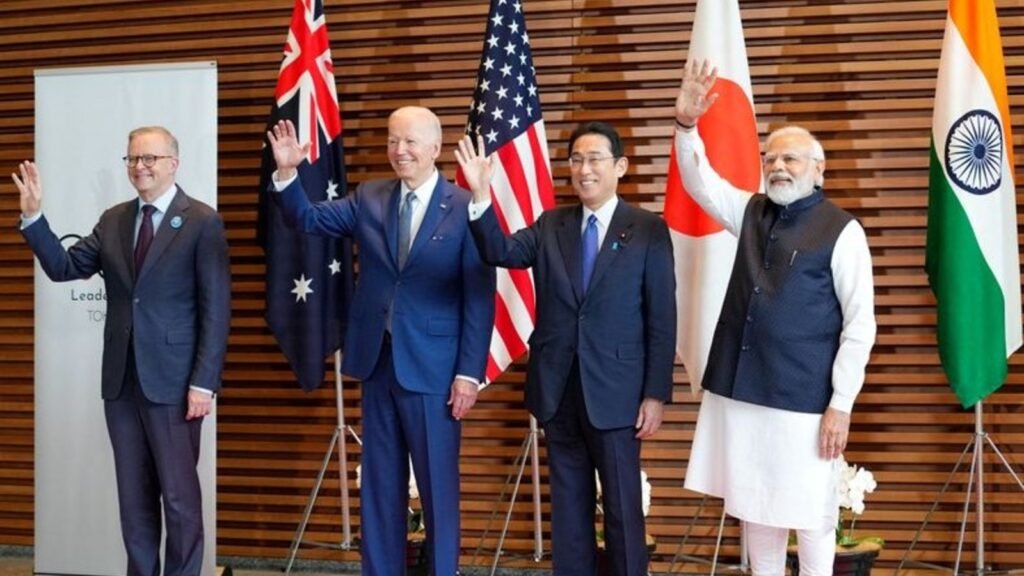
Quad Marks 20 Years of Cooperation
Why in News?
Recently, the Quad foreign ministers’ meeting held in Tokyo focused on addressing key global issues and emphasized expanding cooperation. The major highlights include:
- Efforts to end violence in Ukraine, Gaza, and Myanmar.
- Plans to expand the Indo-Pacific Partnership for Maritime Domain Awareness (IPMDA) into the Indian Ocean Region (IOR).
What is Quad?
The Quad (Quadrilateral Security Dialogue) is an informal diplomatic partnership between Australia, India, Japan, and the United States. The group is committed to:
- Supporting an open, stable, and prosperous Indo-Pacific.
- Promoting inclusivity, resilience, and a rules-based international order.
Origins and Evolution:
- The idea was first proposed by Japanese Prime Minister Shinzo Abe in 2007.
- Initial setbacks included Australia’s withdrawal due to Chinese pressure.
- In 2017, the Quad was formally established, with India, Australia, Japan, and the US coming together to form a quadrilateral coalition.
Key Objectives:
- Freedom of Navigation: Ensuring unhindered access to sea-lanes critical for global trade.
- Countering Regional Challenges: Addressing China’s growing influence in the Indo-Pacific region.
- Promoting Collaboration: Enhancing cooperation in areas like maritime security, climate change, and technology sharing.
What is the Indo-Pacific Partnership for Maritime Domain Awareness (IPMDA)?
The IPMDA initiative was announced at the Quad Leaders’ Summit in Tokyo (2022). It focuses on:
- Integrating Pacific Islands, Southeast Asia, and the Indian Ocean Region (IOR) into the Indo-Pacific framework.
Objectives of IPMDA:
- Tracking Dark Shipping:
- Monitors vessels that turn off their Automatic Identification System (AIS) to avoid detection, often linked to illegal activities such as smuggling or unregulated fishing.
- Tactical-Level Monitoring:
- Provides real-time data to respond effectively to climate events, humanitarian crises, and maritime security threats.
- Supports sustainable fisheries management, vital for economies in the Indo-Pacific.
Significance for India:
- Enhances security and stability in the Indo-Pacific, a region of global strategic importance.
- Bolsters India’s maritime strength, with the Indian Navy’s fleet set to expand to 170-180 vessels by 2028.
What is the Indian Ocean Region (IOR)?
The Indian Ocean Region (IOR) encompasses over 36 littoral and island nations. It is strategically crucial due to its:
- Trade Routes: Includes critical sea-lanes such as:
- Strait of Hormuz: Vital for global oil transportation.
- Strait of Malacca: A chokepoint for international trade and energy supply.
- Natural Resources: Rich reserves of minerals, hydrocarbons, and marine biodiversity.
Challenges in the IOR:
- Piracy: Ongoing threats to commercial shipping.
- Illegal Fishing: Depletes marine resources and impacts livelihoods.
- Environmental Degradation: Due to pollution, overfishing, and climate change.
India’s Role in IOR:
- Focuses on regional cooperation and sustainable development.
- Collaborates with key players like China, US, and regional organizations to address challenges.
Other Groupings in the Indian Ocean Region (IOR):
- Indian Ocean Rim Association (IORA):
- An intergovernmental organization established in 1997.
- Aims to promote economic cooperation, regional integration, and sustainable development among Indian Ocean nations.
- AUKUS:
- A trilateral security partnership between Australia, UK, and US, formed in 2021.
- Focuses on countering China’s influence in the South China Sea.
- Includes:
- Sharing US nuclear submarine technology with Australia.
- Collaboration in emerging technologies like AI, quantum computing, and undersea capabilities.
Key Terms and Explanations:
- Quad:
- An informal strategic partnership focusing on the Indo-Pacific region.
- Promotes shared values such as freedom of navigation and a rules-based international order.
- Indo-Pacific:
- A geopolitical term referring to the region spanning the Indian Ocean and the Pacific Ocean, encompassing critical trade routes and economies.
- Dark Shipping:
- Refers to vessels turning off their AIS (Automatic Identification System) to evade detection, often associated with illegal activities.
- Automatic Identification System (AIS):
- A maritime tracking system mandated for ships to enhance safety, security, and transparency in international waters.
- Indian Ocean Rim Association (IORA):
- Promotes economic growth, development, and regional stability among member nations in the Indian Ocean region.
- AUKUS:
- A trilateral partnership designed to enhance security and technological capabilities in the Indo-Pacific.
Conclusion:
The Quad’s 20-year journey highlights its pivotal role in shaping the geopolitical landscape of the Indo-Pacific. By focusing on issues such as maritime security, climate resilience, and regional cooperation, the Quad underscores its commitment to a free, inclusive, and rules-based international order.
The expansion of initiatives like IPMDA and the strategic emphasis on the Indian Ocean Region (IOR) reflect the growing importance of these areas for global security and trade. Collaborations with other platforms like IORA and AUKUS further solidify the region’s role in ensuring peace, stability, and sustainable development.
The Quad continues to serve as a counterbalance to China’s growing influence, reaffirming its vision of a resilient and prosperous Indo-Pacific.




